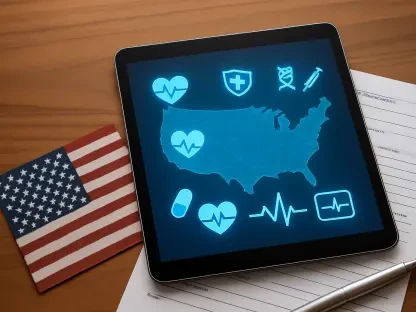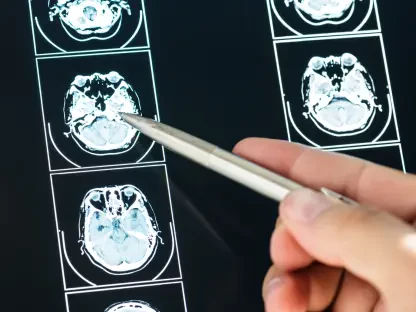The healthcare sector stands at a transformative crossroads, grappling with intricate challenges and promising opportunities in applying payer insights to close care gaps. As the field transitions from legacy systems and outdated practices towards digital innovation, stakeholders in health tech and data interoperability find themselves positioned to reimagine healthcare delivery. Central to this narrative is the utilization of payer insights—not merely a technological feat but a potential catalyst for transformative change. By integrating payer and provider data, healthcare systems aim to streamline workflows, enhance patient outcomes, and reduce administrative burdens. A strategic focus on data synthesis and seamless connectivity can pave the way for innovative solutions in bridging care and knowledge gaps.
The Evolution of Healthcare Data
Transition from Paper to Digital Platforms
The healthcare sector’s evolution from paper-based to digital platforms highlights the shifting landscape in medical technology. Over the years, stakeholders have aimed to enhance interoperability to allow more seamless exchange of health information. This transition involves replacing inefficient processes, such as using fax machines, with advanced digital records, providing an opportunity to rectify pervasive data silos and the fragmentary nature of information exchange. As progress continues, the sector aims to achieve greater efficiency, transparency, and accuracy in clinical data management, fostering a cohesive ecosystem where insights can promote patient care improvements.
At the forefront of this digital transformation is the integration of Electronic Health Records (EHRs) into broader clinical settings. By eliminating the “crowded desktop” experience that many healthcare providers face, EHRs present transformative possibilities for streamlining workflows and fostering interoperability. The transition is often seen as fraught with challenges, requiring concerted efforts to align technological advances with industry demands. Solutions like Veradigm, which focus on bridging the connectivity gap between payers and providers, are critical in setting a framework where clinical data can be efficiently aggregated and analyzed.
Enhancing Interoperability and Data Synthesis
Interoperability represents a central pillar in advancing healthcare technology, allowing for the fluid exchange of clinical and claims data. By embracing interoperability, providers and payers can generate valuable intelligence, offering a more comprehensive view of patient care. This capability allows stakeholders to address substantial outcomes, from reducing hospitalizations to improving treatment accuracy, based on synthesized insights. Despite this promise, many healthcare systems experience difficulties due to fragmented approaches and disparate platforms, which hinder effective information-sharing.
Collaborating on interoperability initiatives can provide mutual benefits for healthcare providers and payers. By establishing efficient data exchange models, these stakeholders position themselves to improve care quality and reduce gaps. Solutions that support clinical workflows without necessitating external applications offer reduced complexity and enhanced operational effectiveness. Building intuitive systems that bridge data gaps empowers clinicians at the point of care, permitting timely and efficient interventions. With appropriate scalability and integration strategies, such initiatives are set to counter existing challenges, forging a path towards a more unified healthcare system.
Overcoming Challenges in Healthcare
Addressing Administrative Burdens in Health Technology
Administrative burden has historically represented a significant challenge for healthcare professionals, posing obstacles to seamless service delivery and care outcomes. Within the field of health technology, these burdens are often shaped by intricate tasks related to data entry, claims management, and electronic record navigation—issues that complicate daily operations and detract from clinical efficiency. Solutions that streamline these processes can significantly reduce administrative hurdles, providing the necessary bandwidth for healthcare professionals to focus on patient care and treatment innovation.
One of the key initiatives to mitigate administrative strain involves integrating technologies that automate and simplify data management tasks. By employing AI tools for routine functions like data entry and predictive text, healthcare settings can alleviate workflow complexities. Such applications not only enhance speed and accuracy in data handling but also allow professionals to engage more meaningfully with patient care. Technologies that provide meaningful insights into patient conditions and treatment pathways can spark newfound efficiencies in care delivery, positioning the industry to adopt a more proactive and patient-centric model.
Navigating Provider and Payer Collaboration
The dynamic between healthcare providers and payers signifies a crucial component in advancing healthcare innovation. Traditionally characterized by fragmented data sharing and a siloed approach, collaboration within these roles is beginning to transform. Payers, equipped with comprehensive patient data from various sources, are now positioned to offer essential insights to providers. These insights can support providers in identifying overlooked conditions or delivering proactive care interventions, enhancing patient outcomes.
Efforts to establish streamlined communications and workflows between providers and payers are paving the path towards more collaborative relationships. With the integration of tools that facilitate seamless insight-sharing, payers can relay crucial health data to providers in real time. Providers, leveraging these insights, can engage more proactively in treatment decisions and preventive care measures. Establishing a bidirectional communication channel not only strengthens the collaboration framework but also amplifies the ability to respond to emerging health challenges effectively. As initiatives like Veradigm continue to foster this alignment, healthcare stakeholders are better poised to actualize transformative impacts for patient care.
Bridging Insights and Outcomes
Empowering Stakeholders with Comprehensive Patient Views
Amid the evolving landscape of health technology, delivering a comprehensive patient view during provider-patient interactions represents a fundamental step towards improving patient outcomes. The ability to address open conditions and enhance preventive care measures during clinical encounters rests on synthesizing insights from both payer and provider databases. By empowering stakeholders—payers, providers, and patients—with a holistic view of patient care patterns, opportunities emerge for advocacy and improved decision-making in treatment settings.
Comprehensive patient views are increasingly seen as pivotal in navigating healthcare complexities. They allow providers to anticipate patient needs and align treatment pathways with emerging patterns and insights. This capability helps mitigate care gaps and fuels efforts to foster patient engagement and adherence. By leveraging payer insights to inform clinical decisions, stakeholders can better address evolving patient needs, crafting personalized interventions that resonate meaningfully with individual health trajectories.
Streamlining Insights Integration
While delivering payer insights promises transformative impacts, achieving this has not been without its challenges. A prevalent issue remains the overwhelming amount of data available, which risks overloading healthcare providers and detracting from effective decision-making. Providers may find themselves navigating an array of applications and decision-support tools—resources intended to streamline processes but often complicate them instead. Establishing solutions that integrate insights directly into clinical workflows represents a critical step in truly harnessing this data for improved care delivery.
Solutions that allow straightforward integration of payer insights can significantly enhance the usability and acceptance of these tools within healthcare settings. Effective frameworks promise to simplify workflows, encourage timely interventions, and foster improved provider-payer communication. As these processes become more intuitive and direct, healthcare professionals stand better positioned to leverage data insights effectively, advancing their ability to respond to complex health scenarios proactively. Tools that offer seamless integration and intuitive design continue to hold transformative potential for the ecosystem as they strive to convert data overload into actionable clinical intelligence.
Fostering Trust and Collaboration
Trust as a Pillar for Health Tech Adoption
Trust represents a foundational element in healthcare’s evolving dynamic, dictating the pace of technological adoption and transformation in clinical settings. For providers to embrace new tools and insights, there needs to be confidence in their efficacy, security, and compatibility with existing workflows. Without trust, the ability to foster meaningful innovation and collaboration becomes limited, hindering the potential benefits that technology offers. Therefore, establishing transparent channels and assurances in data management and sharing processes is critical in achieving stakeholder alignment.
Providers often weigh the practical benefits of adopting health tech tools against the perceived risk to operational stability and patient confidentiality. Tools that demonstrate stringent security measures and exhibit seamless integration capabilities are more likely to secure provider trust and foster collaborative relationships. By prioritizing transparency, healthcare systems can create an environment conducive to open information exchange, strengthening partnerships between payers, providers, and patients. Such ecosystems allow stakeholders to explore emerging technologies with confidence, enhancing care delivery and driving forward collaborative health strategies.
Aligning Incentives for Sustainable Care Models
Beyond technology, the alignment of incentives plays a crucial role in shaping healthcare’s future. As the industry migrates from fee-for-service towards value-based and risk-based care paradigms, stakeholders are increasingly incentivized to prioritize patient care and outcomes. Shared incentives pave the way for synergies between payers and providers, motivating them to collaborate meaningfully and adapt care models that emphasize holistic health management and sustainable practices.
Aligning incentives within risk-based care requires stakeholders to consider a balanced framework that promotes shared goals while safeguarding individual roles. When providers and payers converge on aligned incentives, they create a platform for collaborative innovation, potentially leading to improved care delivery and efficiency. As strategies evolve, efforts to align financial and care incentives can thrive amidst an ecosystem where payer insights directly inform clinical decision-making, optimizing patient outcomes. Such approaches hold the promise to drive sustainable care models, offering forward-thinking pathways for healthcare advancement.
Advancing Towards Future-Ready Healthcare
The shift from paper to digital platforms in healthcare underscores the changing landscape of medical technology. This transition aims to enhance interoperability, allowing seamless health information exchange. Moving away from outdated processes like fax machines to advanced digital records presents an opportunity to address data silos and the fragmented nature of information exchange. With ongoing progress, the sector seeks improved efficiency, transparency, and accuracy in managing clinical data, thus creating a cohesive environment that boosts patient care.
Central to this digital revolution is the integration of Electronic Health Records (EHRs) into extensive clinical settings. EHRs eliminate the cluttered, overfilled desktops that many healthcare professionals encounter, offering transformative potential for streamlining workflows and enhancing interoperability. This transition isn’t without its challenges, necessitating synchronized efforts to align tech progress with industry needs. Solutions like Veradigm, which bridge the connectivity gap between payers and providers, are vital in establishing a framework for efficient clinical data aggregation and analysis.









